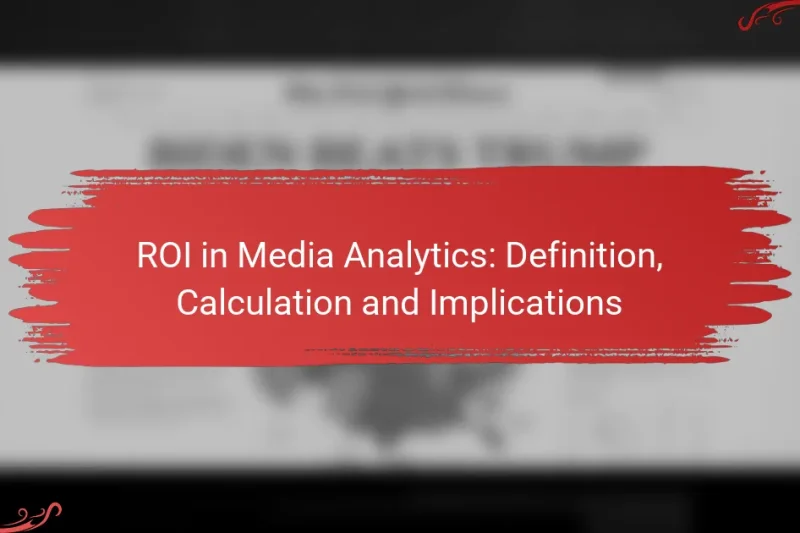Key Performance Indicators (KPIs) are essential tools for measuring the effectiveness of display advertising campaigns. By … Key Performance Indicators: Definition, Importance and ApplicationsRead more
Understanding Media Metrics
Understanding media metrics is crucial for enhancing the performance of display advertising. By leveraging data-driven insights, advertisers can optimize their campaigns, improve targeting, and gain a deeper understanding of their audience. Key metrics such as click-through rate (CTR), cost per mille (CPM), and conversion rate are essential for assessing campaign effectiveness and guiding strategic decisions.
Audience Engagement Metrics: Types, Importance and Measurement
Understanding audience engagement metrics is essential for evaluating how users interact with your content. By measuring … Audience Engagement Metrics: Types, Importance and MeasurementRead more
Media Metrics: Selection Criteria, Alignment with Goals and Impact
In the realm of display advertising, selecting the right media metrics is crucial for evaluating campaign … Media Metrics: Selection Criteria, Alignment with Goals and ImpactRead more
Media Metrics Tools: Features, Usability and Integration
Media metrics tools are essential for marketers looking to enhance their display advertising efforts by providing … Media Metrics Tools: Features, Usability and IntegrationRead more
ROI in Media Analytics: Definition, Calculation and Implications
Return on Investment (ROI) in media analytics is a crucial metric that quantifies the effectiveness of … ROI in Media Analytics: Definition, Calculation and ImplicationsRead more
Media Metrics: Strategic Decision-Making, Campaign Optimization and Performance Tracking
Media metrics play a crucial role in enhancing campaign optimization and informing strategic decision-making. By analyzing … Media Metrics: Strategic Decision-Making, Campaign Optimization and Performance TrackingRead more
How can media metrics improve display advertising performance?
Media metrics enhance display advertising performance by providing data-driven insights that inform targeting, optimization, and audience understanding. By analyzing key metrics, advertisers can make informed decisions that lead to more effective campaigns and better returns on investment.
Enhanced targeting accuracy
Enhanced targeting accuracy allows advertisers to reach specific demographics, interests, and behaviors effectively. By utilizing metrics such as click-through rates and conversion rates, advertisers can refine their audience segments, ensuring that ads are shown to the most relevant users.
For example, if a campaign shows higher engagement from users aged 25-34, advertisers can adjust their targeting parameters to focus more on this age group. This precision helps in reducing wasted impressions and increasing the likelihood of conversions.
Increased ROI through optimization
Increased return on investment (ROI) is achieved by continuously optimizing ad campaigns based on performance metrics. Advertisers can track which ads perform best and allocate budgets accordingly, maximizing the effectiveness of their spend.
Common optimization strategies include A/B testing different ad creatives and adjusting bidding strategies based on real-time performance data. By focusing on high-performing ads, advertisers can see significant improvements in ROI, often in the range of 20-50% over time.
Better audience insights
Better audience insights come from analyzing metrics that reveal user behavior and preferences. Understanding how audiences interact with ads helps advertisers tailor their messaging and creative to better resonate with potential customers.
For instance, metrics like time spent on ad content and engagement rates can inform advertisers about what captivates their audience. This knowledge enables the creation of more relevant and compelling ads, ultimately leading to higher engagement and conversion rates.
What are the key media metrics for display advertising?
The key media metrics for display advertising include click-through rate (CTR), cost per mille (CPM), and conversion rate. These metrics help advertisers assess the effectiveness and efficiency of their campaigns, guiding optimization efforts and budget allocation.
Click-through rate (CTR)
Click-through rate (CTR) measures the percentage of users who click on an ad after viewing it. A higher CTR indicates that the ad is engaging and relevant to the audience. Typically, a good CTR for display ads ranges from 0.5% to 2%, but this can vary based on industry and ad placement.
To improve CTR, focus on creating compelling ad copy and visuals that resonate with your target audience. A/B testing different versions of your ads can also help identify which elements drive more clicks.
Cost per mille (CPM)
Cost per mille (CPM) refers to the cost of acquiring 1,000 impressions of an ad. This metric is crucial for budgeting and comparing the cost-effectiveness of different advertising channels. CPM rates can vary widely, often ranging from a few dollars to over $50, depending on factors like audience targeting and ad placement.
When evaluating CPM, consider the quality of impressions and the potential reach of your ads. A lower CPM might not always be better if it results in lower engagement or conversions.
Conversion rate
The conversion rate measures the percentage of users who take a desired action after clicking on an ad, such as making a purchase or signing up for a newsletter. A strong conversion rate indicates that the ad effectively drives users to complete the intended action. Typical conversion rates for display ads can range from 1% to 5% or more, depending on the industry and offer.
To enhance conversion rates, ensure that the landing page aligns with the ad’s message and provides a seamless user experience. Implementing clear calls to action and optimizing page load times can significantly impact conversions.
How to analyze media metrics effectively?
To analyze media metrics effectively, focus on key performance indicators (KPIs) that align with your goals. This involves collecting data, interpreting it accurately, and making informed decisions based on insights gained.
Utilizing Google Analytics
Google Analytics is a powerful tool for tracking website performance and user behavior. It provides insights into traffic sources, user demographics, and engagement metrics, allowing you to assess which content resonates most with your audience.
To get started, set up goals that reflect your objectives, such as newsletter sign-ups or product purchases. Regularly review reports on user behavior and conversion rates to identify trends and areas for improvement.
Employing A/B testing
A/B testing involves comparing two versions of a webpage or content to determine which performs better. This method helps you make data-driven decisions by isolating variables and measuring their impact on user engagement and conversion rates.
When conducting A/B tests, ensure you have a clear hypothesis and a sufficient sample size for reliable results. Common elements to test include headlines, call-to-action buttons, and layout designs. Aim for a testing duration that captures a representative user behavior pattern, typically a few weeks.
Leveraging heatmaps for user engagement
Heatmaps visually represent user interactions on a webpage, showing where users click, scroll, and spend time. This data helps identify which areas of your site attract attention and which may need improvement.
To leverage heatmaps effectively, use them in conjunction with other analytics tools. Focus on high-traffic pages and analyze the heatmap data to optimize layout and content placement. Regularly update your heatmaps to reflect changes in user behavior and site design.
What tools can help track media metrics?
Several tools are available to effectively track media metrics, each offering unique features tailored to different needs. Choosing the right tool depends on the specific metrics you want to analyze and the platforms you utilize for your media campaigns.
Adobe Analytics
Adobe Analytics is a powerful tool for tracking media metrics across various digital platforms. It provides in-depth insights into user behavior, allowing businesses to analyze traffic sources, conversion rates, and engagement levels.
When using Adobe Analytics, consider setting up custom dashboards to visualize key performance indicators (KPIs) relevant to your media campaigns. This can help streamline reporting and facilitate data-driven decision-making.
Facebook Ads Manager
Facebook Ads Manager is essential for tracking metrics related to advertising on Facebook and Instagram. It offers detailed analytics on ad performance, including reach, impressions, click-through rates, and conversion tracking.
To maximize the effectiveness of Facebook Ads Manager, regularly review your ad metrics and adjust your targeting and budget accordingly. This iterative approach can improve your return on investment (ROI) and overall campaign success.
Tableau for data visualization
Tableau is a leading data visualization tool that can help you present media metrics in a clear and engaging manner. It allows users to create interactive dashboards that can integrate data from various sources, providing a comprehensive view of media performance.
When using Tableau, focus on creating visualizations that highlight trends and patterns in your media metrics. This can aid in identifying areas for improvement and making informed strategic decisions based on the data.
What are the challenges in measuring media metrics?
Measuring media metrics presents several challenges that can complicate data accuracy and interpretation. Key issues include navigating data privacy regulations, understanding attribution complexities, and addressing cross-device tracking issues.
Data privacy regulations
Data privacy regulations, such as the General Data Protection Regulation (GDPR) in Europe and the California Consumer Privacy Act (CCPA) in the United States, impose strict guidelines on how personal data can be collected and used. These laws require organizations to obtain explicit consent from users, which can limit the amount of data available for analysis.
To comply with these regulations, companies must implement transparent data collection practices and ensure users are informed about how their data will be used. Failure to adhere to these regulations can result in significant fines and damage to reputation.
Attribution complexities
Attribution complexities arise when trying to determine which marketing efforts are responsible for conversions. With multiple touchpoints in a customer journey, it can be challenging to assign credit accurately to each channel, leading to potential misinterpretation of data.
To address this, marketers can use attribution models such as first-click, last-click, or multi-touch attribution. Each model has its pros and cons, so selecting the right one depends on the specific goals and strategies of the marketing campaign.
Cross-device tracking issues
Cross-device tracking issues occur when users interact with content across multiple devices, making it difficult to create a cohesive view of their behavior. This fragmentation can lead to incomplete data and hinder the ability to measure the effectiveness of media campaigns accurately.
To mitigate these challenges, businesses can utilize user authentication methods or device fingerprinting techniques. However, these methods must be balanced with privacy considerations to ensure compliance with regulations and maintain user trust.
How do media metrics vary by region?
Media metrics can differ significantly across regions due to cultural preferences, technology access, and local regulations. Understanding these variations is crucial for effective media strategy and audience engagement.
Differences in user behavior in North America
User behavior in North America is shaped by a blend of technology adoption and content consumption habits. Audiences tend to favor streaming services, with a significant portion of viewing time dedicated to platforms like Netflix and Hulu. This shift has led to a decline in traditional TV viewership.
Engagement metrics, such as average watch time and interaction rates, often reflect a preference for on-demand content. Users typically spend several hours per week consuming digital media, with mobile devices playing a key role in this trend.
Marketers should focus on optimizing content for mobile platforms and consider the impact of time zones when scheduling releases. Tailoring content to reflect local interests can enhance engagement and improve overall media metrics.




